Embedded Systems Beginner’s Progression: Key Milestones
01 Basic Stage 1.1 Basics of Programming Languages C Language: As the cornerstone of embedded development, it is essential to master its various features. By carefully studying classic books such as “The C Programming Language,” deeply understand the syntax rules, accurately grasp the use of data types, skillfully manipulate pointers as a powerful tool, and … Read more









